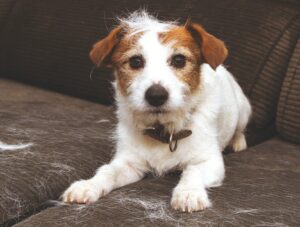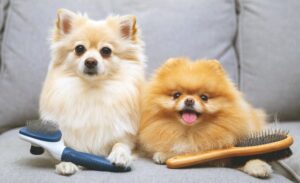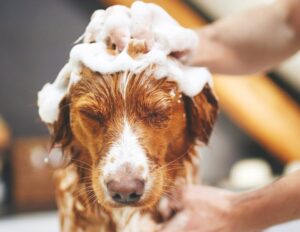Mastering the Art of seasonal shedding
You call it dog hair, but pet parents call it treasure. Spring is the season when your house gets this treasure in abundance. Here are some tips to manage seasonal spring shedding in your furry friend.
 Typically spring and fall-autumn are the two seasons in which dogs shed the most. With spring on our door and summer ready to roll, you need to be prepared to manage shedding in your pet so that his coat remains healthy and your home remains clean.
Typically spring and fall-autumn are the two seasons in which dogs shed the most. With spring on our door and summer ready to roll, you need to be prepared to manage shedding in your pet so that his coat remains healthy and your home remains clean.
Taming the tufts
For a lot of new pet parents who are experiencing shedding for the first time for their furry friends, it can be a matter of concern. But you don’t have to worry at all. It is a natural phenomenon. They have fur, it will grow and shed. But a lot of pet parents don’t know the hair growth cycle of their pets and its stages –
- Anagen phase: New hair grows
- Catagen phase: Hair reaches its maximum length and ceases to grow further
- Telogen phase: Hair remains in a resting state, neither growing nor falling out
- Exogen phase: Hair naturally sheds, or fur is shed from the coat
No matter what your pet’s breed is, shedding is important to maintain his coat and skin health. Through shedding your pet gets rid of his old hair and it makes way for new and shiny hair. Shedding also helps them get acclimatized to changing temperature of spring.
Tips to manage shedding serenade
- Rooting for regular brushing : Regular grooming is an integral part of your pet’s wellbeing, especially during shedding season. Brush his hair thoroughly and make sure there are no matts and tangles. You should also check the skin underneath the coat for any skin infections or abrasions, as they are common in this season. Make it a point to brush your furry friend 10 minutes daily and you’ll see what a difference it will make to his coat and your bond!
- Tools that are too good : Getting the right tools solves a majority of shedding woes. Make sure you get in touch with a professional groomer to know which brush would be best suitable for your pet based on his coat length and type.
Here are some examples of brushes suitable for different dog breeds –
![]() Slicker Brush: It is ideal for breeds with long, curly, or wavy coats such as Golden Retrievers, Yorkshire Terriers, and Poodles. Since these brushes have fine wire bristles they are effective in removing tangles, mats, and loose fur without causing any discomfort to your beloved pet.
Slicker Brush: It is ideal for breeds with long, curly, or wavy coats such as Golden Retrievers, Yorkshire Terriers, and Poodles. Since these brushes have fine wire bristles they are effective in removing tangles, mats, and loose fur without causing any discomfort to your beloved pet.- Undercoat Rake: Suitable for double-coated breeds like German Shepherds, Huskies, and Malamutes. It penetrates through the dense undercoat to effectively remove loose fur, reduce shedding, and prevent matting.
- Bristle Brush: This one work best for breeds with short, smooth coats such as Beagles, Dachshunds, and Boxers. Bristle brushes have soft, natural bristles that remove dirt, debris, and loose hair while distributing natural oils to maintain a healthy and shiny coat.
- Pin Brush: Recommended for breeds with long, silky coats like Shih Tzus, Afghan Hounds, and Collies. Pin brushes have rounded metal pins that gently detangle and remove loose hair without damaging your pet’s coat.
- Rubber Curry Brush: It is suitable for breeds with short coats or sensitive skin, such as Bulldogs, Dobermans, and Chihuahuas. These brushes are characterized by soft rubber bristles that massage the skin, remove loose hair, and stimulate blood circulation.
![]() De-shedding Tool: Ideal for breeds prone to heavy shedding, such as Labrador Retrievers, Bernese Mountain Dogs, and Chow Chows. De-shedding tools have a specialized blade that effectively removes loose undercoat fur to reduce shedding and minimize matting.
De-shedding Tool: Ideal for breeds prone to heavy shedding, such as Labrador Retrievers, Bernese Mountain Dogs, and Chow Chows. De-shedding tools have a specialized blade that effectively removes loose undercoat fur to reduce shedding and minimize matting.- Mat Breaker: Mat breaker is an important tool for breeds prone to matting, such as Poodles, Bichon Frise’s, and Old English Sheepdogs. They have sharp blades or teeth that cut through mats and tangles to prevent discomfort and skin irritation.
- Flea Comb: Flea comb is useful for all breeds to detect and remove fleas, flea eggs, and flea dirt from the coat. These have fine teeth that trap fleas and their eggs while grooming.
- Wire-Pin Brush: Suitable for breeds with wiry or coarse coats like Wire Fox Terriers, Scottish Terriers, and Airedale Terriers. These brushes have firm, angled pins that penetrate the coat to remove debris and prevent matting.
- Grooming Glove: It is a versatile option for breeds of all coat types, especially those who have sensitive skin. Grooming gloves have rubber or silicone bristles that mimic the feel of a massage while removing loose hair and debris.
Say yes to bath time : A lot of dogs are water babies and love spending their time playing around in water. After the chilling winter, spring is the time that you can increase the frequency of baths for your pet.
Giving your pet a bath can help in loosening fur, allowing the loose fur to fall into the tub rather than onto your carpet. Choose a natural pet-friendly shampoo that’s free of sulphates, nasties, and any harsh chemicals. And if your pet has a specific skin condition, you can ask your vet to recommend a medicated shampoo and conditioner to suit his skin and coat.
![]() Good diet goes a long way : Nutrition is the key to maintain your pet’s skin and coat. Ensure your dog is receiving a balanced diet rich in essential fatty acids, vitamins, and minerals. Ask your vet to make a specific diet chart for your furry friend based on his age, gender, and overall health condition.
Good diet goes a long way : Nutrition is the key to maintain your pet’s skin and coat. Ensure your dog is receiving a balanced diet rich in essential fatty acids, vitamins, and minerals. Ask your vet to make a specific diet chart for your furry friend based on his age, gender, and overall health condition.- The magic of supplements : Just like you take supplements for your hair, skin, and nails, you should consider adding dietary supplements to your pet’s wellness routine. Omega 3 fatty acid or fish oil capsules work the best to maintain a shiny coat and well hydrated skin. Get in touch with your vet to know more about the benefits of fish oil capsules for your pet and which omega supplements would be the best for him.
The amalgamation of a healthy diet and the right kind of supplements will definitely show great results for your pet’s healthy coat and skin.
- Trust the professionals : We know you take utmost care of your furry friend and his grooming needs at home, but it cannot match what professionals do! Consider taking your dog to a professional groomer for a thorough grooming session, especially during heavy shedding periods. Professional groomers have specialized tools and techniques to reduce shedding effectively.
Taking care of your pet’s coat and skin is a lifelong process and you cannot expect overnight results. You need to be consistent with a routine of grooming, supplements, and good diet and that’s when you can see visible results.


 Slicker Brush: It is ideal for breeds with long, curly, or wavy coats such as Golden Retrievers, Yorkshire Terriers, and Poodles. Since these brushes have fine wire bristles they are effective in removing tangles, mats, and loose fur without causing any discomfort to your beloved pet.
Slicker Brush: It is ideal for breeds with long, curly, or wavy coats such as Golden Retrievers, Yorkshire Terriers, and Poodles. Since these brushes have fine wire bristles they are effective in removing tangles, mats, and loose fur without causing any discomfort to your beloved pet. De-shedding Tool: Ideal for breeds prone to heavy shedding, such as Labrador Retrievers, Bernese Mountain Dogs, and Chow Chows. De-shedding tools have a specialized blade that effectively removes loose undercoat fur to reduce shedding and minimize matting.
De-shedding Tool: Ideal for breeds prone to heavy shedding, such as Labrador Retrievers, Bernese Mountain Dogs, and Chow Chows. De-shedding tools have a specialized blade that effectively removes loose undercoat fur to reduce shedding and minimize matting. Good diet goes a long way : Nutrition is the key to maintain your pet’s skin and coat. Ensure your dog is receiving a balanced diet rich in essential fatty acids, vitamins, and minerals. Ask your vet to make a specific diet chart for your furry friend based on his age, gender, and overall health condition.
Good diet goes a long way : Nutrition is the key to maintain your pet’s skin and coat. Ensure your dog is receiving a balanced diet rich in essential fatty acids, vitamins, and minerals. Ask your vet to make a specific diet chart for your furry friend based on his age, gender, and overall health condition.